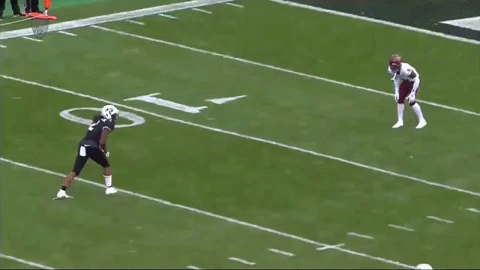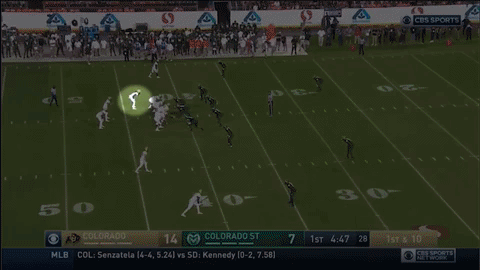© 2025 ALLCITY Network Inc.
All rights reserved.

Laviska Shenault Jr. may be the best receiver in college football.
Sure, you’ll probably hear more fans and analysts say that title belongs to Alabama’s Jerry Jeudy. A few might give Oklahoma’s CeeDee Lamb the nod. There’s some room for debate.
What’s undeniable is that Shenault is the most versatile offensive weapon in the country.
I don’t want to spoil this film room, but he lines up outside, he lines up in the slot, he lines up at tight end, he lines up at H-back, he lines up at running back, he even lines up behind center in short-yardage situations.
The crazy part is that he’s an absolute monster wherever Colorado puts him.
In my first film room for BSN Buffs, I want to break down what makes Shenault one of college football’s premier must-see athletes, but also share a major concern that has bothered me since I first sat down to watch Buffs tape a couple of months ago.
Shenault in his natural position
Here’s the surprising thing about Shenault as a wide receiver: He’s still pretty raw.
That isn’t to say you shouldn’t buy into the hype or that he isn’t ready for the next level. To be honest, I’d buy even more stock in him because he isn’t done growing as an outside presence.
Right now, Shenault is just too big, too fast, too athletic and too strong for college defenders (and probably a lot of pros, too). His game is reminiscent of Antonio Gates, Jimmy Graham and Julius Thomas, three former college basketball players who converted to tight end during college.
Shenault wins one-on-one battles predominantly because he’s a world-class athlete, not because he’s the most refined in his technique.
Just check out his last-minute, game-winning touchdown at Nebraska:

And this touchdown against Arizona State:

While he’s obviously a dominant receiver, there’s still plenty of room for Shenault to refine his game.
If you look back through those clips, you’ll notice that none of these plays were easy for Shenault. He’s relying on his athleticism and strong hands to convert difficult opportunities.
The next step for Shenault, at least as a true wide receiver, is to learn how to create better separation from defensive backs. Right now, he relies a lot on size to box out opposing cornerbacks then come back to get the ball.

He’s just so big and so strong, Pac-12 defensive backs don’t have a chance against him. In this clip, look at how he gives a half shove to the cornerback at the top of his route to clear space.

Now compare that to this route from Jerry Jeudy, the other top receiver in this draft class. Jeudy uses a big jab step and head fake to lose a defensive back, then gets wide open on the sideline where he can wait in space to pull in the pass.

It’s just so easy for him.
If Shenault can improve his route running, he’ll have more opportunities for easy, high-percentage catches like this one, instead of just boxing out or jumping over defenders.
Last season, it was rare for Shenault to run routes 5 to 20 yards downfield, so his seeming lack of separation could have been influenced by small sample size, but this is what it looked like most of the time he ran real routes. Not a whole lot of separation here, he’s just too talented for that to matter.

I don’t mean to come off too critical of Shenault’s game. The man averaged more than 10 catches per game, more than 130 receiving yards per game and found the end zone more than once per game. He was at the top of the Heisman watchlist at the midpoint of the season, before he got hurt. Right now, as a 20-year-old, he could be in an NFL camp instead of the Buffs’ and he would turn heads. As Kalyn Kahlen of MMQB reported hearing from an agent, “Shenault will be the strongest receiver in the NFL the day he’s drafted.”
One area where Shenault does well to gain separation is off the line of scrimmage. He has elite burst, which is one of the reasons he’s such a threat downfield. Watch him beat the defensive back early and hold him off for a big gain:

He’s also spectacular at feeling space against zone coverage. In this clip, he recognizes the space afforded to him on the sideline, so he sells the safety on a fly route, before flattening out the break on a corner route, so he’ll wind up naked on the sideline.

There are two other things worth recognizing in this clip. First, Shenault’s feet look very good. Second, Montez has the ball waiting for Shenault out of the break. That’s the type of chemistry you hope to see this season.
For Shenault, there’s still room for improvement, which should terrify opposing defenses.
Shenault as a hybrid
Last year, the Buffs used Shenault in almost every offensive skill position. He played receiver, tight end, fullback and tailback. This year, we’ll likely see more of the same.
I want to explore two of Shenault’s occasional roles in further detail.
Shenault lined up at H-back frequently throughout the season. This was one of his most effective positions because of the variety of different jobs the play-callers could give him. He could run routes, he could stay back in pass protection or he could be used as a decoy.
Much of the Buffs’ strategy with Shenault was to get him the ball in space, so he could make a play with his feet. One way they did this was by putting Shenault at H-back. Shenault would cut back against the grain on run plays and light up the edge defender. After a few goes, Shenault would slip the block and release into space in the flat.
Here’s the setup:

Here’s the counter:

The Buffs want to get the ball in his hands because Shenault is an incredible ball-carrier. He averaged 7.3 yards after the catch per reception last season, the second-most in college football per PFF.
At 225 pounds, it’s no surprise Shenault can run over defensive backs, but he also has the agility to put defenders on their backs without even touching them:

The Buffs also used Shenault as wildcat quarterback in short-yardage situations, and I don’t remember an instance when he didn’t pick up the first down.
Here’s a touchdown against Arizona State:

Here’s a longer touchdown against USC:

Shenault is hugely valuable because of his versatility, but…
The Big Question
It’s 3rd-and-11 against Nebraska. Steven Montez is in the shotgun with five wideouts.
Who’s he looking to first? Shouldn’t even be a question, right?
Let’s find out:

Well, that was… strange. Montez was buried so quickly you may not have noticed, but in an obvious passing situation, needing 11 yards, the Buffs’ Heisman-caliber receiver isn’t on the field
The first-down play explains why:

Shenault carried the ball five yards and limped to the sideline grabbing his shoulder. Then he sat on the bench during a play when his talents would be significantly more beneficial.
The injury lingered all game. When Shenault walked off the field after the Buffs’ final possession (where he scored the game-winning touchdown) he didn’t move his right arm and took off his helmet with his left hand.

Shenault missed time in the first game of the season, as well, after he plowed into the line of scrimmage to pick up a first down out of the wildcat.

Shenault is a great ball-carrier, but he might not be top five in the Pac-12. At wideout, he’s the best in the league by a wide margin.
If Shenault’s ability at receiver is the cake, his ability at tight end is the icing. Running back is the sprinkles. Fullback can be a big mound of whipped cream. H-back is the candles or something. We’re running out of metaphors for wildcat quarterback… maybe just a miniature, edible Heisman figurine to put on top?
The point is that, for Shenault, everything starts with his value on the perimeter.
A five-yard run might be worth the hit he takes at the end of it. It also might not be. However, if we were to measure Shenault’s “yards gained per hit taken” last year and compare his rate with other top NCAA receivers, I doubt Buffs fans would want to see the result.
Shenault is clearly a plus player at any skill position on offense, but determining how exactly to use him is difficult. Last year, the Buffs asked him to lay his body on the line in a variety of different ways, because he’s talented enough to contribute on every play.

There aren’t many elite receivers who would be willing to dive head-first into a defensive lineman to set up a running back; in part because there aren’t many receivers who could make the play effectively in the first place, but mostly because of the diva mentality stereotypical of wideouts.
Limiting the situations where Shenault is most likely to wind up hurt — whether seriously or just a stinger — may be beneficial. But, at the same time, if Colorado makes a surprise run at bowl eligibility or even a Pac-12 title, Shenault will need to play like a Heisman finalist on every down.
The team’s best chance at success may be to ask Shenault to contribute on every offensive snap —whether that’s catching bombs downfield, running head-on into linebackers for four-yard gains, or blasting defensive linemen — and hoping he stays healthy.
Since Shenault is almost certain to enter the 2020 NFL Draft, the Buffs may be more likely to take a “get everything you have out of the guy while you have him” approach.
I don’t claim to have the answers, but I sure have a lot of questions.
And my biggest question heading into camp is this: How will Mel Tucker and his staff employ Laviska Shenault Jr. in 2019?
Comments
Share your thoughts
Join the conversation



